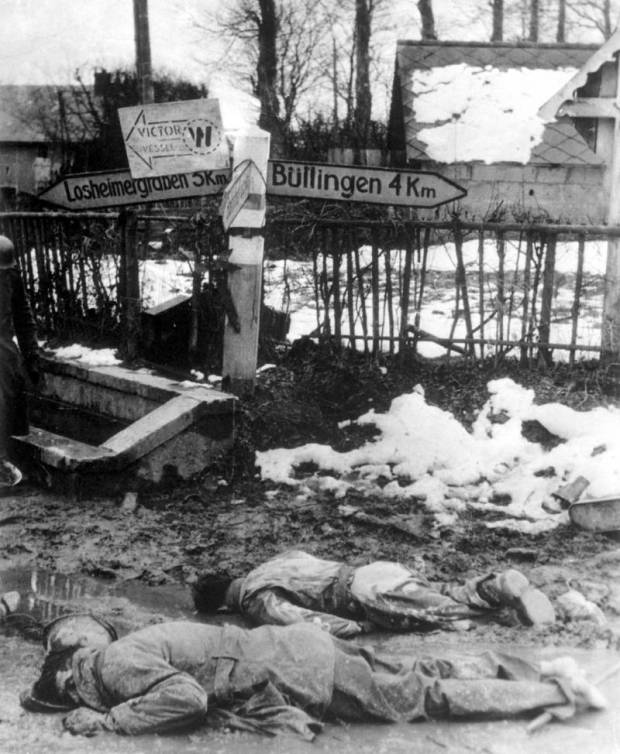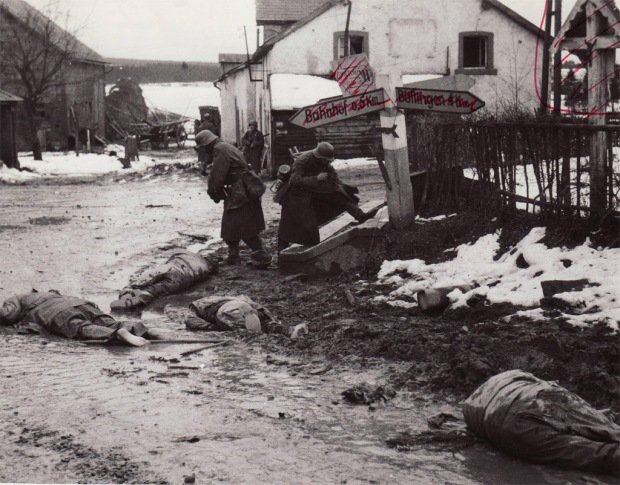
General Anthony Clement “Nuts” McAuliffe (July 2, 1898 – August 11, 1975) was a senior United States Army officer, who earned fame as the acting commander of the U.S. 101st Airborne Division troops defending Bastogne, Belgium, during the Battle of the Bulge towards the end of World War II.

On December 22, 1944, at about 11:30 in the morning, a group of four German soldiers, waving two white flags, approached the American lines using the Arlon Road from the direction of Remoifosse, south of Bastogne.

The group consisted of two officers and two enlisted men. The senior officer was a Major Wagner of the 47th Panzer Corps. The junior officer, Lt. Hellmuth Henke of the Panzer Lehr Operations Section, was carrying a briefcase under his arm. The two enlisted men had been selected from the 901st Panzer Grenadier Regiment.

The Americans defending in that location were members of F Company of the 327th Glider Infantry Regiment, 101st Airborne Division. The Germans walked past a bazooka team in a foxhole in front of the Kessler farm and stopped in front of the foxhole of PFC Leo Palma, a B.A.R. gunner. Palma described the officers as wearing long overcoats and shiny black boots. Lieutenant Henke, who spoke English said, “I want to see the commanding officer of this section.” Palma was at a loss for words, but Staff Sergeant Carl E. Dickinson who had been manning a position nearby walked out to the road and called the group over to him. The Germans explained that they had a written message to be presented to the American Commander in Bastogne.
Henke said they would consent to being blindfolded and taken to the American Commanding Officer. In fact, they had brought blindfolds with them. Henke blindfolded Wagner and Dickinson blindfolded Henke. As the blindfolds were being applied, Dickinson was joined by PFC Ernest Premetz, a German-speaking medic of his platoon who offered to serve as an interpreter. However no interpreter was needed.
General von Lüttwitz dispatched the party, to deliver an ultimatum. Entering the American lines southeast of Bastogne (occupied by Company F, 2nd Battalion, 327th Glider Infantry), the German party delivered the following to Gen. McAuliffe
dispatched the party, to deliver an ultimatum. Entering the American lines southeast of Bastogne (occupied by Company F, 2nd Battalion, 327th Glider Infantry), the German party delivered the following to Gen. McAuliffe
The German surrender demand was typewritten on two sheets. One was in English, the other in German. They had been typed on an English typewriter as indicated by the fact that the diacritical marks required on the German copy had been entered by hand.

According to those present when McAuliffe received the German message, he read it, crumpled it into a ball, threw it in a wastepaper basket, and muttered, “Aw, nuts”. The officers in McAuliffe’s command post were trying to find suitable language for an official reply when Lt. Col. Harry Kinnard suggested that McAuliffe’s first response summed up the situation pretty well, and the others agreed.

The official reply was typed and delivered by Colonel Joseph Harper, commanding the 327th Glider Infantry, to the German delegation.

It was as follows:

The German major appeared confused and asked Harper what the message meant. Harper said, “In plain English? Go to hell.” The choice of “Nuts!” rather than something earthier was typical for McAuliffe. Vincent Vicari, his personal aide at the time, recalled that “General Mac was the only general I ever knew who did not use profane language. ‘Nuts’ was part of his normal vocabulary.”
(Brig. Gen. Anthony McAuliffe and his staff gathered inside Bastogne’s Heintz Barracks for Christmas dinner Dec. 25th, 1944. This military barracks served as the Division Main Command Post during the siege of Bastogne, Belgium during WWII. The facility is now a museum known as the “Nuts Cave”.)

The artillery fire did not materialize, although several infantry and tank assaults were directed at the positions of the 327th Glider Infantry. In addition, the German Luftwaffe attacked the town, bombing it nightly. The 101st held off the Germans until the 4th Armored Division arrived on December 26 to provide reinforcement.

For his actions at Bastogne, McAuliffe was awarded the Distinguished Service Cross by General Patton on December 30, 1944, followed later by the Distinguished Service Medal.
Immediately after Bastogne, McAuliffe was promoted to Major General and given command of the 103rd Infantry Division on January 15, 1945, his first divisional command assignment, which he retained until July 1945. Under McAuliffe, the 103rd reached the Rhine Valley, March 23, and engaged in mopping up operations in the plain west of the Rhine River. In April 1945, the division was assigned to occupational duties until April 20, when it resumed the offensive. Pursuing a fleeing enemy through Stuttgart and taking Münsingen on April 24. On April 27, elements of the division entered Landsberg, where Kaufering concentration camp, a subcamp of Dachau, was liberated. The 103rd crossed the Danube River near Ulm on April 26. On May 3, 1945, the 103rd captured Innsbruck, Austria, with little to no fighting. It then seized the Brenner Pass and met the 88th Infantry Division of the U.S. Fifth Army at Vipiteno, Italy, thereby joining the Italian and Western European fronts.

One of the soldiers whom McAuliffe awarded the Silver Star to was the baseball player, Sidney Kohlsachs. However, Kohlsachs would become known for not accepting the medal because, as he put it, “My fallen brothers are much more deserving than I.”


I am passionate about my site and I know you all like reading my blogs. I have been doing this at no cost and will continue to do so. All I ask is for a voluntary donation of $2, however if you are not in a position to do so I can fully understand, maybe next time then. Thank you.
To donate click on the credit/debit card icon of the card you will use. If you want to donate more then $2 just add a higher number in the box left from the PayPal link. Many thanks.


 One of his tasks during the war was to defuse land mines, and he also fought in the Battle of the Bulge.
One of his tasks during the war was to defuse land mines, and he also fought in the Battle of the Bulge.


















 dispatched the party, to deliver an ultimatum. Entering the American lines southeast of Bastogne (occupied by Company F, 2nd Battalion, 327th Glider Infantry), the German party delivered the following to Gen. McAuliffe
dispatched the party, to deliver an ultimatum. Entering the American lines southeast of Bastogne (occupied by Company F, 2nd Battalion, 327th Glider Infantry), the German party delivered the following to Gen. McAuliffe














You must be logged in to post a comment.